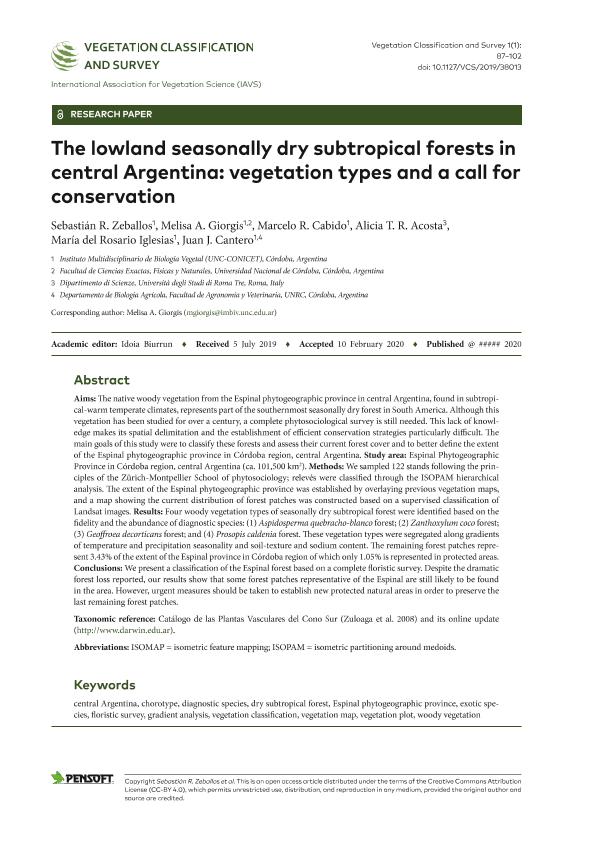Mostrar el registro sencillo del ítem
dc.contributor.author
Zeballos, Sebastián Rodolfo

dc.contributor.author
Giorgis, Melisa Adriana

dc.contributor.author
Cabido, Marcelo Ruben

dc.contributor.author
Acosta, Alicia Teresa Rosario

dc.contributor.author
Iglesias, María del Rosario

dc.contributor.author
Cantero, Juan Jose

dc.date.available
2020-06-05T18:48:09Z
dc.date.issued
2020-04
dc.identifier.citation
Zeballos, Sebastián Rodolfo; Giorgis, Melisa Adriana; Cabido, Marcelo Ruben; Acosta, Alicia Teresa Rosario; Iglesias, María del Rosario; et al.; The lowland seasonally dry subtropical forests in central Argentina: vegetation types and a call for conservation; Pensoft Publishers; Vegetation Classification and Survey; 1; 4-2020; 87-102
dc.identifier.uri
http://hdl.handle.net/11336/106772
dc.description.abstract
The native woody vegetation from the Espinal phytogeographic province in central Argentina, found in subtropical-warm temperate climates, represents part of the southernmost seasonally dry forest in South America. Although this vegetation has been studied for over a century, a complete phytosociological survey is still needed. This lack of knowledge makes its spatial delimitation and the establishment of efficient conservation strategies particularly difficult. The main goals of this study were to classify these forests and assess their current forest cover and to better define the extent of the Espinal phytogeographic province in Córdoba region, central Argentina. Study area: Espinal Phytogeographic Province in Córdoba region, central Argentina (ca. 101,500 km2). Methods: We sampled 122 stands following the principles of the Zürich-Montpellier School of phytosociology; relevés were classified through the ISOPAM hierarchical analysis. The extent of the Espinal phytogeographic province was established by overlaying previous vegetation maps, and a map showing the current distribution of forest patches was constructed based on a supervised classification of Landsat images. Results: Four woody vegetation types of seasonally dry subtropical forest were identified based on the fidelity and the abundance of diagnostic species: (1) Aspidosperma quebracho-blanco forest; (2) Zanthoxylum coco forest; (3) Geoffroea decorticans forest; and (4) Prosopis caldenia forest. These vegetation types were segregated along gradients of temperature and precipitation seasonality and soil-texture and sodium content. The remaining forest patches represent 3.43% of the extent of the Espinal province in Córdoba region of which only 1.05% is represented in protected areas. Conclusions: We present a classification of the Espinal forest based on a complete floristic survey. Despite the dramatic forest loss reported, our results show that some forest patches representative of the Espinal are still likely to be found in the area. However, urgent measures should be taken to establish new protected natural areas in order to preserve the last remaining forest patches.Taxonomic reference: Catálogo de las Plantas Vasculares del Cono Sur (Zuloaga et al. 2008) and its online update (http://www.darwin.edu.ar).Abbreviations: ISOMAP = isometric feature mapping; ISOPAM = isometric partitioning around medoids.Keywordscentral Argentina, chorotype, diagnostic species, dry subtropical forest, Espinal phytogeographic province, exotic sp
dc.format
application/pdf
dc.language.iso
eng
dc.publisher
Pensoft Publishers
dc.rights
info:eu-repo/semantics/openAccess
dc.rights.uri
https://creativecommons.org/licenses/by-nc-sa/2.5/ar/
dc.subject
CENTRAL ARGENTINA
dc.subject
CHOROTYPE
dc.subject
DIAGNOSTIC SPECIES
dc.subject
DRY SUBTROPICAL FOREST
dc.subject.classification
Conservación de la Biodiversidad

dc.subject.classification
Ciencias Biológicas

dc.subject.classification
CIENCIAS NATURALES Y EXACTAS

dc.title
The lowland seasonally dry subtropical forests in central Argentina: vegetation types and a call for conservation
dc.type
info:eu-repo/semantics/article
dc.type
info:ar-repo/semantics/artículo
dc.type
info:eu-repo/semantics/publishedVersion
dc.date.updated
2020-06-02T13:36:36Z
dc.identifier.eissn
2683-0671
dc.journal.volume
1
dc.journal.pagination
87-102
dc.journal.pais
Austria

dc.journal.ciudad
Viena
dc.description.fil
Fil: Zeballos, Sebastián Rodolfo. Consejo Nacional de Investigaciones Científicas y Técnicas. Centro Científico Tecnológico Conicet - Córdoba. Instituto Multidisciplinario de Biología Vegetal. Universidad Nacional de Córdoba. Facultad de Ciencias Exactas Físicas y Naturales. Instituto Multidisciplinario de Biología Vegetal; Argentina
dc.description.fil
Fil: Giorgis, Melisa Adriana. Consejo Nacional de Investigaciones Científicas y Técnicas. Centro Científico Tecnológico Conicet - Córdoba. Instituto Multidisciplinario de Biología Vegetal. Universidad Nacional de Córdoba. Facultad de Ciencias Exactas Físicas y Naturales. Instituto Multidisciplinario de Biología Vegetal; Argentina
dc.description.fil
Fil: Cabido, Marcelo Ruben. Consejo Nacional de Investigaciones Científicas y Técnicas. Centro Científico Tecnológico Conicet - Córdoba. Instituto Multidisciplinario de Biología Vegetal. Universidad Nacional de Córdoba. Facultad de Ciencias Exactas Físicas y Naturales. Instituto Multidisciplinario de Biología Vegetal; Argentina
dc.description.fil
Fil: Acosta, Alicia Teresa Rosario. Consejo Nacional de Investigaciones Científicas y Técnicas. Centro Científico Tecnológico Conicet - Córdoba. Instituto Multidisciplinario de Biología Vegetal. Universidad Nacional de Córdoba. Facultad de Ciencias Exactas Físicas y Naturales. Instituto Multidisciplinario de Biología Vegetal; Argentina. Università degli Studi di Roma Tre; Italia
dc.description.fil
Fil: Iglesias, María del Rosario. Consejo Nacional de Investigaciones Científicas y Técnicas. Centro Científico Tecnológico Conicet - Córdoba. Instituto Multidisciplinario de Biología Vegetal. Universidad Nacional de Córdoba. Facultad de Ciencias Exactas Físicas y Naturales. Instituto Multidisciplinario de Biología Vegetal; Argentina
dc.description.fil
Fil: Cantero, Juan Jose. Universidad Nacional de Río Cuarto; Argentina. Consejo Nacional de Investigaciones Científicas y Técnicas. Centro Científico Tecnológico Conicet - Córdoba. Instituto Multidisciplinario de Biología Vegetal. Universidad Nacional de Córdoba. Facultad de Ciencias Exactas Físicas y Naturales. Instituto Multidisciplinario de Biología Vegetal; Argentina
dc.journal.title
Vegetation Classification and Survey
dc.relation.alternativeid
info:eu-repo/semantics/altIdentifier/doi/http://dx.doi.org/10.1127/VCS/2019/38013
dc.relation.alternativeid
info:eu-repo/semantics/altIdentifier/url/https://vcs.pensoft.net/article/38013/
Archivos asociados
